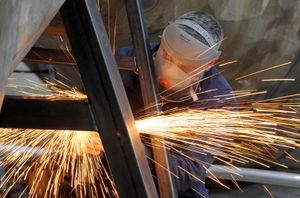Giant artwork with creative message being made on Shropshire border
It is the size of two double decker buses, stands seven metres high, weighs nine-and-a-half tonnes – and is being created on the Shropshire border.

The sculpture, ‘Messenger’, being created at the Castle Fine Arts Foundry, will be the largest bronze to be cast in the UK.
This week the artist Joseph Hillier was at the foundry in Llanrhaeadr, near Oswestry, to see how Messenger is taking shape.
He has worked with the foundry for several projects but this is by far the biggest so far.
The sculpture was commissioned to stand outside the Theatre Royal in Plymouth and depicts a young actor in mid-performance, crouched ready to spring forward.
Joseph said his creation embodies the energy and creativity at the heart of the Theatre Royal and cultural life in Plymouth and celebrates the links between the theatre and the theatre company, Frantic Assembly.
Technique
It is being cast by 30 staff working on the project at the foundry and will take almost a year to complete using the ancient technique of lost wax casting.
“Made from over 200 bronze panels which each weigh 35 kilos, each section of the sculpture must be cast individually before being welded together,” Joseph said.
“It is by far the largest bronze sculpture by volume at 25.6 metres cubed.”
While monumental in scale, Hillier is keen that the digital design of the sculpture, made using 360-degree computer aided design will be clearly visible when unveiled, showing a true marriage of technology and tradition, old and new.
“We are living in a digital world where to often we don’t convert what is digital into something permanent,” he said.
Chris Butler, founder of the Castle Fine Arts Foundry, said: “The foundry creates a silicon rubber mould around each polyurethane panel to make a negative version of each of the 200 panels which are then hand-painted with layers of wax.
“A shell of ceramic is then built around the wax. This is fired in a kiln, which burns off the wax but leaves behind a hard-ceramic surround. Ingots of bronze are then heated to 1200 degrees C before the molten bronze is poured into the new ceramic mould. Once set, the ceramic shell is broken away leaving behind the bronze version of the pattern.
“Once each of the 200 bronze panels are forged, they are then welded together to create the finished sculpture.”
Joseph Hillier said: “By combining contemporary technology with ancient sculptural processes this piece of sculpture will harness a moment from the work of the Theatre Royal Plymouth and present it at a monumental scale in bronze for perpetuity.
“The work is an attempt to capture a vital, fleeting moment from a performance and hold it as solid tangible form, to stand as a monument to creativity, to transform the way Plymouth is seen and its potential felt.”
The artist, who lives near Newcastle, has 17 large-scale permanent installations nationally and internationally.





